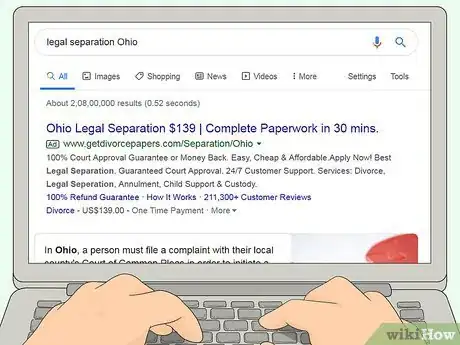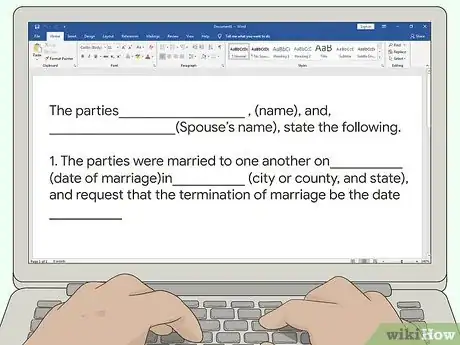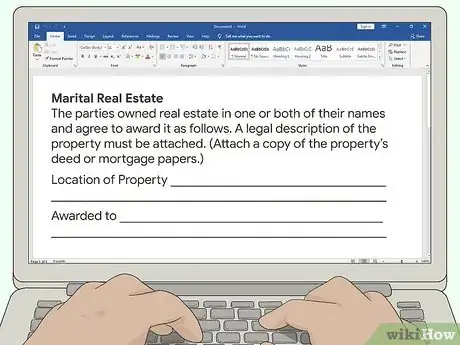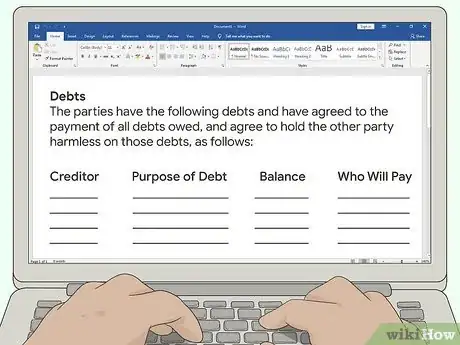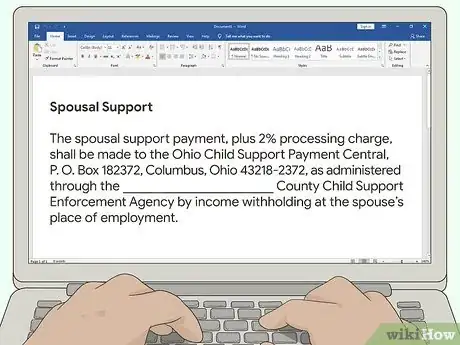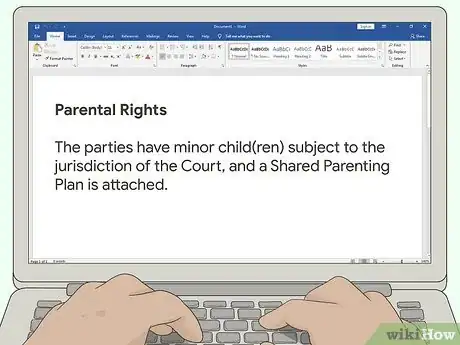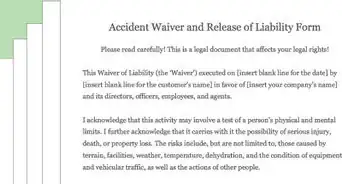This article was written by Jennifer Mueller, JD. Jennifer Mueller is an in-house legal expert at wikiHow. Jennifer reviews, fact-checks, and evaluates wikiHow's legal content to ensure thoroughness and accuracy. She received her JD from Indiana University Maurer School of Law in 2006.
There are 7 references cited in this article, which can be found at the bottom of the page.
This article has been viewed 98,032 times.
Even the most amicable of separations is never easy, but having a written separation agreement can take some of the guesswork out of navigating your lives independent of each other. If you want your separation agreement to be a legal document, it needs to cover all the same bases a divorce agreement would, including marital property, real estate, debts, and children (if you have any). Negotiating a separation agreement will make the divorce process easier if you end up taking that route. It can also help the separation itself run more smoothly, allowing you to focus on yourselves and each other if you're trying to find a path toward reconciliation.[1]
Steps
Negotiating with Your Partner
-
1Approach negotiations from an objective, neutral standpoint. It can be easy to let emotions get the best of you in this situation, especially if the separation wasn't your idea. Try to look at things objectively, as though you were merely dissolving a business partnership rather than a romantic relationship.[2]
- If there is anything that you aren't willing to compromise on, state that upfront. Your partner may have some things like that as well. If you get those out of the way first, you'll find everything else is that much easier.
- If you're still too upset or emotional to be objective, you might want to consider using a mediator. Your local court will have a list of approved mediators in your area. You can likely also find a list on the webpage for your state or local bar association.
Warning: If you and your partner have serious communication problems, or if there has been a history of abuse or anger management, do not attempt to negotiate a separation agreement on your own. Use a mediator or talk to an attorney.
-
2Determine your priorities and your partner's priorities. Before you sit down and talk to your partner about the separation, both of you should have a clear idea of what you want out of the separation and what things are most important to you. Make a list of the basic categories your separation agreement will cover. Then each of you can set your priorities within those categories. Some of the basic categories you should evaluate are:[3]
- Who stays in the family home
- Division of property, including furniture, cars, personal property, and pets
- Finances, including debts, banking, and investment accounts
- Joint bills and obligations
- Parenting time and child support, if you have children
Tip: Don't be surprised if you and your partner have different priorities when it comes to each of these categories. Figuring out your individual priorities makes it easier to find a way to a compromise both of you can live with.
Advertisement -
3Talk about how to separate your physical property. Much of your physical property will likely be fairly easy to divide, such as clothes, books, and other items. For things that aren't as easy, think about which of you will get more benefit out of it or which of you can replace it more easily.[4]
- When negotiating, it's typically best to start with the easiest things and get them out of the way so you can focus on particular items that might be sticking points. Don't be afraid to bargain with these items. For example, you might agree that your partner can have the newer car if you can have the living room furniture that you picked out.
- If you and your partner own a home, talk about who will live in the home and who will find accommodations elsewhere. If you have children, it usually makes sense for the parent that will have the bulk of the parenting time to also keep the house. However, if one of you dislikes the house or can't afford to make the mortgage payments on it, that's also something to take into consideration.
- In most states, pets are considered property. However, you can also negotiate shared custody of your pets if you want and these arrangements will typically be upheld by a court as long as both of you are in agreement.
-
4Divide your marital debts and other bills. In many states, debts such as mortgages, credit cards, and car loans are the responsibility of both partners, even if they're only in one partner's name. Write up a list of debts and other bills and decide which of you will be responsible for each of them.[5]
- For example, if you have 2 cars, both of which you're still making payments on, you may decide that each of you gets 1 car and is responsible for the car payments for that car.
- If you have credit cards, decide who is responsible for each card. If your partner is responsible for a particular credit card and you have a copy of that card, destroy it or give it to your partner. Likewise, if you have access to the online account, have your partner change the password.
- Other joint bills typically follow the person who has the property associated with that bill. For example, if you are going to live in the house, you typically would be responsible for the mortgage, homeowner's insurance, property taxes, utilities, and other costs associated with the home. If any of these bills is in the other person's name, change the name of the responsible party on the account.
-
5Evaluate your separate income to determine spousal maintenance. If one of you makes significantly more money than the other, you'll likely want to address spousal maintenance. In most states, this is temporary support to allow the lower-income spouse to get situated on their own. Most states have spousal maintenance or spousal support worksheets or calculators that can help you determine whether such payments would be required in your situation.[6]
- For example, if your partner stayed at home to care for your 2 young children while you worked, you may be obligated to pay your partner some support for a few years until they can find a job and start paying bills themselves.
- Instead of actually exchanging money, you can also adjust for income disparity with the way you divide your debts and obligations. For example, if you have 2 cars, both of which you're still making payments on, the partner who makes more money might agree to pay both car payments and maintain insurance, even though each of you gets 1 car.
-
6Work out parenting time and child support arrangements. If you have children, most states require any separation agreement to include parenting time and child support provisions. While you're typically free to make any agreement you want, you can't eliminate one parent's responsibility entirely. This means a court usually won't approve an agreement in which neither parent pays any child support at all.[7]
- Your state has parenting time worksheets and child support calculators available on the internet, usually on the state court's website. Simply search for "child support calculator" with the name of your state, then "parenting time worksheet" with the name of your state. Make sure any forms you use are approved by your state's court system or child services agency.
- If you're planning to get your separation agreement approved by a judge, the judge will likely look at your parenting time and child support agreement separately and may change it. The judge evaluates this agreement based on the best interests of the child, not the best interests of the parents.
-
7Discuss if either of you wants to change your name. If either of you changed your name after the marriage, you might want to change it back to the name you had before the marriage. If so, you can include a clause to this effect in your separation agreement.[8]
- This clause only takes effect if you're planning on getting the separation agreement approved by a judge. Otherwise, your agreement is just a contract between you and your partner, not a court order.
- If you view the separation as a temporary thing while you work out issues, and both of you ultimately hope to get back together, you may find this discussion premature. Still, it doesn't hurt to talk about it.
-
8Decide what happens to the separation agreement in the event of a divorce. If the two of you are creating a separation agreement because you want to live apart for a while and try to work out your problems, divorce is probably the last thing you want to talk about. However, it's a good idea to at least figure out if the things you've agreed on are only temporary or if you would want to make them permanent. There are 4 basic things that can happen to the separation agreement if one of you files for divorce:[9]
- The separation agreement can become part of the divorce agreement, which would mean you would have fewer (if any) issues to deal with if one of you filed for divorce.
- You can create a clause to the effect that the separation agreement goes away if either of you files for divorce, leaving you free to negotiate everything again.
- You can stipulate that parts of the separation agreement will go away while others will stay and become part of the divorce agreement.
- The separation agreement can live on as its own thing, regardless of any divorce agreement. In effect, this means that at least portions of the separation agreement will either become part of the divorce agreement or be superseded by it.
Tip: If you want your divorce to be effective from the earlier date of separation (which can be important for tax reasons), you typically have to agree that the separation agreement becomes part of the divorce agreement, in whole or in part.
Drafting Your Agreement
-
1Find out if your state recognizes legal separation. A few states still recognize legal separation. In those states, a separation agreement may not be enough. You may also need to file a petition and attend a court hearing to ask the judge to approve your separation agreement.[10]
- The website of your state's court system typically states out front whether the state recognizes legal separation or not. Search for "legal separation" with the name of your state.
- In states that recognize legal separation, you can still have a separation agreement between you and your partner and not go through the court process. However, you may have a difficult time getting the agreement enforced if there are problems, and you likely won't be able to merge it with the divorce agreement if either of you files for divorce.
-
2Look for state-specific separation agreement forms. Your state's court system likely has fill-in-the-blank forms you can use to create a basic separation agreement. Search for "separation agreement" with the name of your state. If you can't find forms on the website for your state's court system, you may be able to find them through your state's legal aid society. If your state recognizes legal separation and you plan to file for that, you'll also need a form for the petition to file along with your agreement.[11]
- You may be able to find other general forms from online legal services for free, but these forms typically are not approved by your state's court system, so you can't guarantee that a court would enforce them.
- Some state courts do not have pre-approved forms. However, if you go to the clerk's office of the nearest civil court or family court, you may be able to get a copy of a separation agreement filed by someone else that you can use as a guide for the basic form of the agreement.
- There are online commercial legal services, such as LegalZoom and RocketLawyer, that may also have state-specific separation agreements. Typically, you'll have to pay to get a custom agreement made. However, these agreements typically are reviewed by a staff lawyer and are less expensive than hiring a lawyer to draft an agreement for you.
-
3Identify each of the partners and the details of your marriage. The first part of a separation agreement lists the full legal names of you and your partner and the date and location of your marriage. Then, you'll need to provide a date when you became legally separated.[12]
- The date of separation doesn't necessarily have to be the exact date one of you moved out. It could be the date you finished negotiating the separation agreement or even a later date. However, it can't be a date before the two of you started living apart.
-
4Outline the division of real estate and personal property. In the next part of your separation agreement, list any real estate and titled property (usually cars, trucks, boats, and other vehicles) that the two of you own and who will get that property. For general household property, you can make descriptions for big things, but usually, you'll just have a general statement to the effect that the two of you have divided up your personal property to your joint satisfaction.[13]
- If you have certain items that are particularly valuable, you might want to include them. For example, if you had antique furniture that was handed down to you from your grandmother, you might want to include specifically that you would get the antique furniture.
- You may also want to make provisions for insurance here, in terms of who is maintaining the insurance on motor vehicles or real estate and has responsibility for paying these bills.
-
5List all banking and investment accounts. Even if you and your partner have separate banking and investment accounts, those may still be considered "marital property." For this reason, include every account in your separation agreement with a clear statement of which partner has the right to the proceeds from that account.[14]
- Some states have particular legal provisions regarding retirement accounts that require them to be divided between married partners. This may not be something you can handle through a separation agreement. If either you or your partner has a retirement account, you may want to talk to a lawyer about how to handle them.
Warning: Do not withhold the existence of accounts from your partner. If you fail to make a full disclosure of all of your financial assets, a court could void your agreement.
-
6Provide a list of al marital debts. Marital debts include all debts incurred in the marriage, even if only one of you is listed on the account. For each account, identify which of you will be responsible for paying that debt.[15]
- If you've agreed to pay off or close accounts, include that in your agreement as well.
- For secured debts, such as a mortgage or a car loan, identify which partner retains possession of the actual property.
Warning: Your separation agreement is only binding on you and your partner. Your creditors are not parties to the separation agreement, and will still come after either or both of you for payment as long as the two of you remain married.
-
7Include your agreement regarding spousal support. If either of you is paying spousal support, list how much is being paid, how often, and for how long. If your state has a spousal support worksheet or calculator, you might attach that to your separation agreement to show how you came to the conclusion you did.[16]
- In most states, you aren't required to provide spousal support at all. However, if a judge needs to approve your separation agreement, they are going to consider whether it is fair and equitable. If one partner makes a lot more money than the other, the judge may order spousal support.
-
8Describe your parenting time and child support arrangements. If you have children, an outline of your parenting time and child support is perhaps the most important part of your separation agreement. If your agreement needs to be approved by a judge, this is the part the judge will scrutinize the most closely.[17]
- Include the names and ages of the children, where they go to school, and who will have primary custody of them. You can attach school schedules as well as a holiday schedule showing your agreement as to who the kids will spend their holidays with. Don't forget to put birthdays on the holiday schedule, as well as days such as Father's Day and Mother's Day.
Finalizing Your Agreement
-
1Provide a copy of the agreement to your partner. Once you've finished your draft of the agreement, give your partner the opportunity to read through it. They might also want to have an attorney look over it as well.[18]
- It can help to give them a deadline so they don't procrastinate. For example, if you email them a copy of it, tell them you want to sign the final agreement in 2 weeks. You can also give them dates and times you're available if they want to meet and discuss it with you.
-
2Discuss any issues not addressed by the agreement. Go back and look at the list of priorities you made and make sure everything that was important to you is covered in the agreement. Your partner should do the same. If anything seems unfair or if you've left anything out, you'll need to go back over the agreement and figure out what needs to be changed.[19]
- Even if you drafted the agreement yourself, it's possible that you overlooked something. Take a step back and evaluate each clause. Think about the future and make sure the agreement is something you can afford and are comfortable with.
- If there's anything you don't feel right about after a second read-through, discuss it with your partner. Expect your partner to potentially have second thoughts about what's in the agreement. They may also want the agreement to cover something that neither of you thought about before. For example, suppose you and your partner have season tickets to the local baseball team. You might want to discuss whether to share these tickets if you continue to get them or simply cancel them.
-
3Make changes to the agreement as necessary. After you and your partner have had the chance to look over the agreement again, add anything else you've thought about or adjust the existing clauses as necessary. Have your partner look over the revised agreement.[20]
- Keep in mind you may end up having to do this several times. Don't expect to cover everything in the first draft of the agreement. Even attorneys can leave things out on the first draft that need to be added later.
-
4Sign the agreement in front of a notary. Once you and your partner decide the agreement is finished, print 2 copies so that each of you has one. Make an appointment with your partner to appear in front of a notary so you can both sign the agreement at the same time. Sign each of the 2 copies so that each of you has an original.[21]
- Each of you will need to bring a valid government-issued photo ID with you. The notary will validate your IDs and confirm that each of you is signing the agreement voluntarily. However, the notary won't read the agreement or evaluate its legality.
-
5File your agreement with the local court. In some states, you have to file your agreement with the family court in your county if you want it to be enforceable. Contact the clerk of court to find out specifically how you need to do this. Typically, you'll bring the original documents to the clerk and have them stamped.[22]
- Some courts may require a cover sheet or other form to accompany your agreement. The clerk will have blank copies of any of these forms.
- You will likely pay a fee to file your agreement with the court. This fee varies among courts but typically isn't more than $200. You and your partner can split the fees if you want, but the entire fee must be paid at the same time.
Tip: If you and your partner now live in different counties, you can usually file the agreement in a court in either county. Typically, you'll want to file your separation agreement in the same court where you would file a divorce petition if you get to that point.
Warnings
- This article covers how to write a separation agreement in the US. If you live in another country, there may be different rules. Set up a free consultation with an attorney who specializes in family law so you can better understand your options.⧼thumbs_response⧽
- In most states, you must live in separate homes to be considered "separated." You cannot, for example, simply live in separate bedrooms in the same home.[25]⧼thumbs_response⧽
- Separation agreements can be long and complex, especially if you and your partner have been together for years and have extensive marital property or children. While you can draft a separation agreement yourself, it's best to have an attorney do it for you.[26]⧼thumbs_response⧽
References
- ↑ https://www.nycbar.org/get-legal-help/article/family-law/marital-agreements/separation-agreement/
- ↑ https://www.divorcemag.com/articles/crafting-a-separation-agreement
- ↑ https://www.divorcemag.com/articles/crafting-a-separation-agreement
- ↑ https://www.divorcemag.com/articles/crafting-a-separation-agreement
- ↑ https://www.divorcemag.com/articles/crafting-a-separation-agreement
- ↑ https://www.divorcemag.com/articles/crafting-a-separation-agreement
- ↑ https://www.masslegalhelp.org/children-and-families/divorce-separation-basic-info
- ↑ https://www.masslegalhelp.org/children-and-families/divorce-separation-basic-info
- ↑ https://www.nycbar.org/get-legal-help/article/family-law/marital-agreements/separation-agreement/
- ↑ https://www.courts.wa.gov/forms/?fa=forms.contribute&formID=25
- ↑ https://www.supremecourt.ohio.gov/JCS/CFC/DRForms/Form16.pdf
- ↑ https://www.supremecourt.ohio.gov/JCS/CFC/DRForms/Form16.pdf
- ↑ https://www.supremecourt.ohio.gov/JCS/CFC/DRForms/Form16.pdf
- ↑ https://www.supremecourt.ohio.gov/JCS/CFC/DRForms/Form16.pdf
- ↑ https://www.supremecourt.ohio.gov/JCS/CFC/DRForms/Form16.pdf
- ↑ https://www.supremecourt.ohio.gov/JCS/CFC/DRForms/Form16.pdf
- ↑ https://www.lawhelpny.org/resource/what-is-legal-separation
- ↑ https://www.divorcemag.com/articles/crafting-a-separation-agreement
- ↑ https://www.divorcemag.com/articles/crafting-a-separation-agreement
- ↑ https://www.divorcemag.com/articles/crafting-a-separation-agreement
- ↑ https://www.nccourts.gov/help-topics/divorce/separation-and-divorce
- ↑ https://www.masslegalhelp.org/children-and-families/divorce-separation-basic-info
- ↑ https://www.divorcemag.com/articles/crafting-a-separation-agreement
- ↑ https://www.divorcemag.com/articles/crafting-a-separation-agreement
- ↑ https://www.nccourts.gov/help-topics/divorce/separation-and-divorce
- ↑ https://www.lawhelpny.org/resource/what-is-legal-separation
About This Article
If you’re legally separating from your spouse, you’ll need to write a separation agreement that you both agree on. Fortunately, many state courts have fill-in-the-blank forms to make the process easier. Your agreement will need to determine who stays in your family home and how your property, capital, assets, and debts are divided. If you have children, you’ll also need to agree on parenting time and child support. If you and your spouse have difficulty communicating, try using a court mediator to help you stay objective. You don’t need an attorney, but it’s best to have one look over your agreement before you sign it to identify any gaps or contradictions. Once you’ve come to an agreement, you’ll need to get it signed in front of a notary, then file it with your local court. For more tips, including how to negotiate areas of disagreement when drafting your separation agreement, read on.








